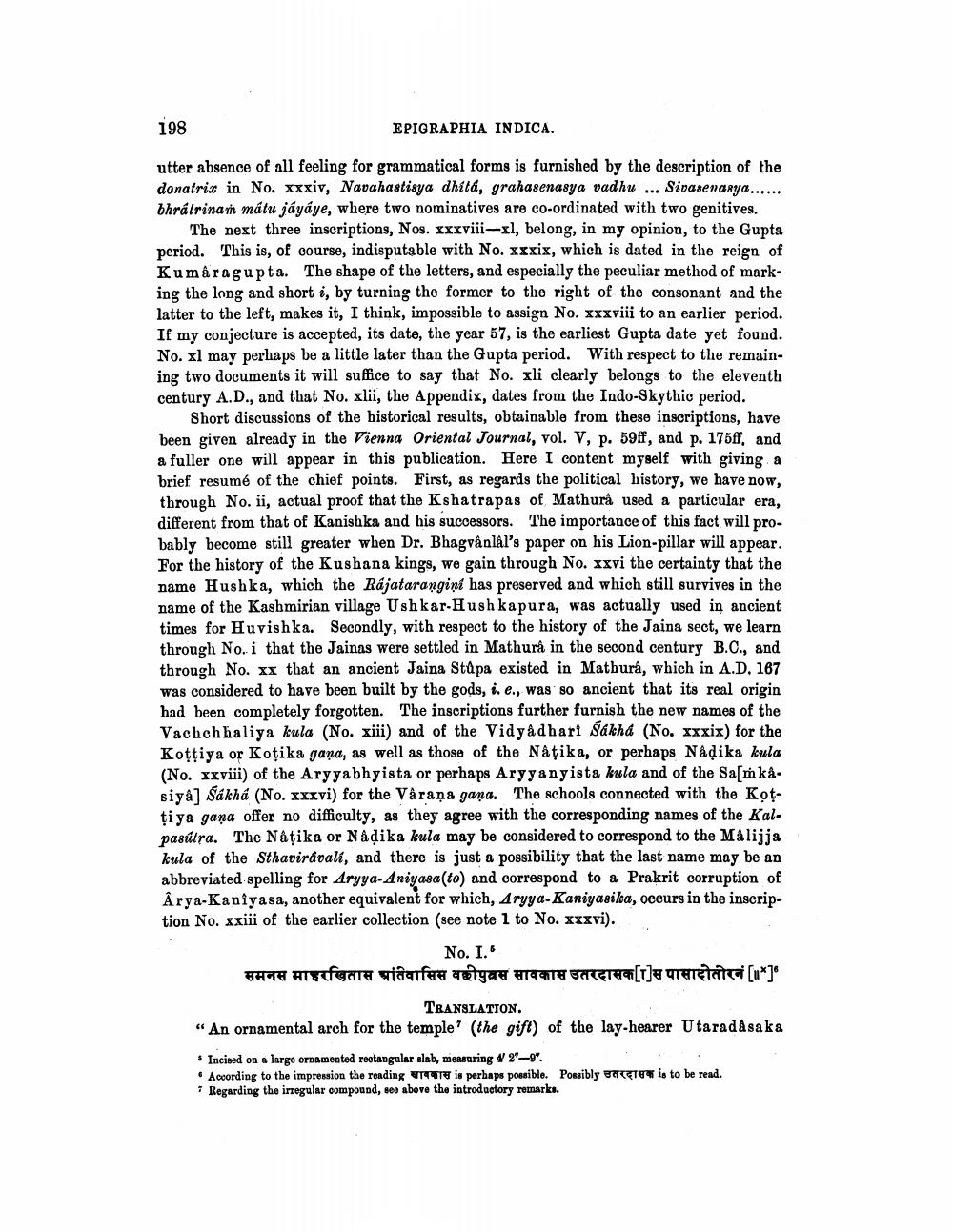________________
198
EPIGRAPHIA INDICA.
utter absence of all feeling for grammatical forms is furnished by the description of the donatrix in No. xxxiv, Navahastisya dhítá, grahasenasya vadhu ... Sivasenasya...... bhrátrinam mátu jáyaye, where two nominatives are co-ordinated with two genitives.
The next three inscriptions, Nos. xxxviii-xl, belong, in my opinion, to the Gupta period. This is, of course, indisputable with No. xxxix, which is dated in the reign of Kumaragupta. The shape of the letters, and especially the peculiar method of marking the long and short i, by turning the former to the right of the consonant and the latter to the left, makes it, I think, impossible to assign No. xxxviii to an earlier period. If my conjecture is accepted, its date, the year 57, is the earliest Gupta date yet found. No. xl may perhaps be a little later than the Gupta period. With respect to the remaining two documents it will suffice to say that No. xli clearly belongs to the eleventh century A.D., and that No. xlii, the Appendix, dates from the Indo-Skythic period.
Short discussions of the historical results, obtainable from these inscriptions, have been given already in the Vienna Oriental Journal, vol. V, p. 59ff, and p. 175ff, and a fuller one will appear in this publication. Here I content myself with giving a brief resumé of the chief points. First, as regards the political history, we have now, through No. ii, actual proof that the Kshatrapas of Mathurâ used a particular era, different from that of Kanishka and his successors. The importance of this fact will probably become still greater when Dr. Bhagvânlâl's paper on his Lion-pillar will appear. For the history of the Kushana kings, we gain through No. xxvi the certainty that the name Hushka, which the Rájatarangini has preserved and which still survives in the name of the Kashmirian village Ushkar-Hush kapura, was actually used in ancient times for Huvishka. Secondly, with respect to the history of the Jaina sect, we learn through No. i that the Jainas were settled in Mathurâ in the second century B.C., and through No. xx that an ancient Jaina Stupa existed in Mathurâ, which in A.D. 167 was considered to have been built by the gods, i. e., was so ancient that its real origin had been completely forgotten. The inscriptions further furnish the new names of the Vachchhaliya kula (No. xiii) and of the Vidyadhart Sakhd (No. xxxix) for the Kottiya or Kotika gana, as well as those of the Nâțika, or perhaps Nâḍika kula (No. xxviii) of the Aryyabhyista or perhaps Aryyanyista kula and of the Sahkasiyâ] Sakha (No. xxxvi) for the Vârana gana. The schools connected with the Kotțiya gana offer no difficulty, as they agree with the corresponding names of the Kalpasdira. The Natika or Nadika kula may be considered to correspond to the Malijja kula of the Sthavirávali, and there is just a possibility that the last name may be an abbreviated spelling for Aryya-Aniyasa (to) and correspond to a Prakrit corruption of Arya-Kaniyasa, another equivalent for which, Aryya-Kaniyasika, occurs in the inscription No. xxiii of the earlier collection (see note 1 to No. xxxvi).
No. I."
समनस माहरखितास प्रतिवासिस वकीपुत्रस सावकास उतरदासक[T]स पासादोतोरनं [॥ *]®
TRANSLATION.
"An ornamental arch for the temple' (the gift) of the lay-hearer Utaradasaka
Incised on a large ornamented rectangular slab, measuring 4' 2"-9".
According to the impression the reading TT is perhaps possible. Possibly are is to be read.
7 Regarding the irregular compound, see above the introductory remarks.




